![]()
HISTORY OF BINGHAM
20th CENTURY
The first half of the century
Bingham changed little at the turn of the 19th century. The population remained less than 1700 until after the Second World War. Until the 1950s few houses in Bingham had mains water and sewerage installed. Water for general use came from wells, but for washing purposes was often collected in soft-water cisterns as 'run off' from roofs. Lighting was by gas, courtesy of the Bingham Gas Company, both for inside the home and for street lighting. For heating there was the domestic fire, and cooking was done on a wood or coal burning stove. Toilet facilities were a shed in the garden with a bucket. This was emptied once a week by the 'night soil' men. There was no secondary education generally available, and most children left school to go to work at age fourteen or earlier.
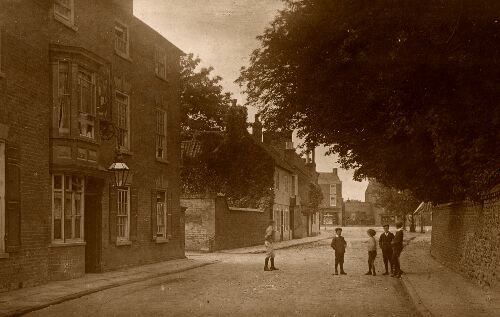
Church Street, looking towards Market Place in the early 1920s. The Chesterfield Arms Inn is on the left. The picture was originally published as a postcard in the Sands Real Photo Series. (Photo provided by Dot Mabbott).
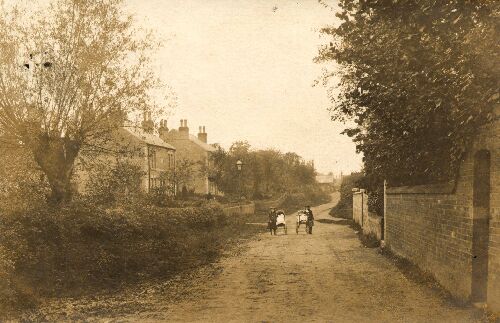
The Banks, looking west. The gate on the right is now the front entrance to No 21, a modern bungalow, but was then the entrance to an orchard behind The Chestnuts (now Long Acre House). Fisher Lane is to the right just behind the two prams. The first visible house beyond the pollard tree is Banks Cottages. The picture is from a postcard, publisher unknown, that was posted on 19th August 1905. Used here by permission of Greg Franks.
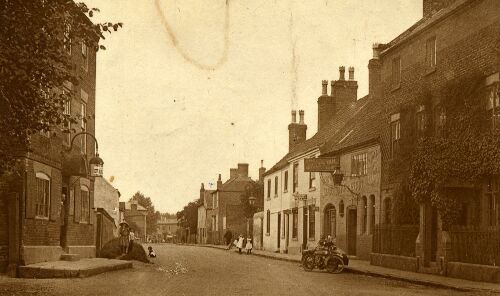
Long Acre from the top of Market Street looking west. The Wheatsheaf pub on the left is opposite The Vaults pub. Shops next to The Vaults moving west at the time of this photograph were Morris's pork shop, Postman Mabbott and Sam Curtiss's fish and chip shop. Just beyond the little girls is a building, which has a various times been used as a Primitive Methodist's (Ranter's) Chapel, the Salvation Army Hall, a betting shop and a pub. The picture, taken before 1915, was published as a postcard by J. Sands and Son. (Photo provided by Dot Mabbott).
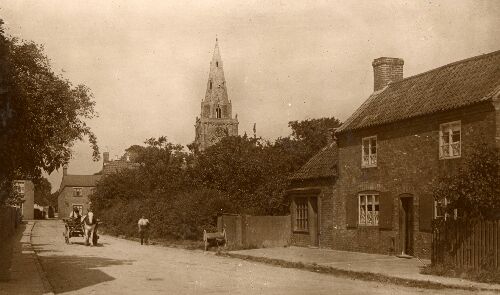
Cherry Street from the Long Acre end, taken in the 1920s. The shop attached to Dane Cottage on the right has been used as a watchmaker's and a grocer's at various times. Albert Nicholson's horse and cart is in the road. Originally oublished as a postcard by Sands. (Photo provided by Dot Mabbott).
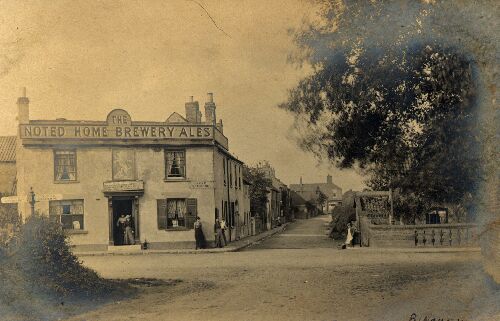
The White Lion and Fairfield Street in 1903. The picture is from a postcard, publisher unknown. Reproduced here by permission of Greg Franks.
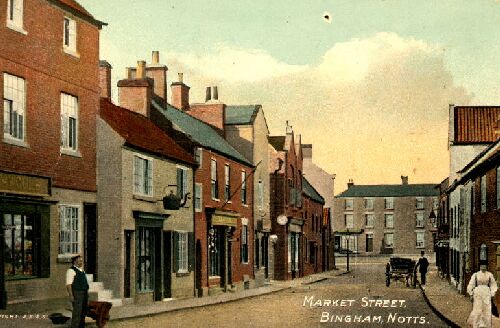
Market Street, looking north. This is a coloured picture used in a postcard, published by J.Sands & Son. This one was posted on 28th January 1917. Reproduced by permission of Greg Franks.
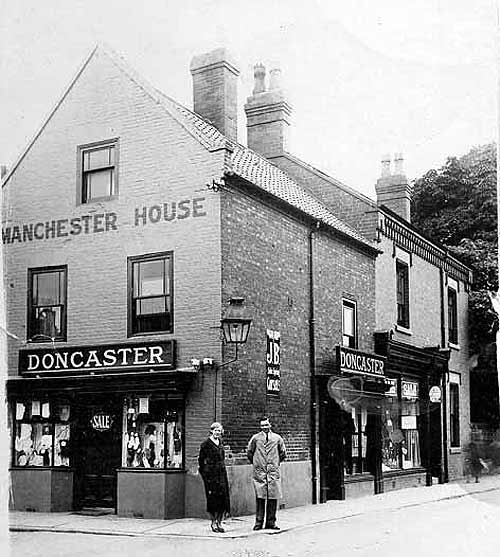
Doncaster's shop at the corner of Church Street and Market Place in the 1920s. Doncaster's was the clothes shop used by everyone in Bingham. Photo by permission of Freda Hayes.
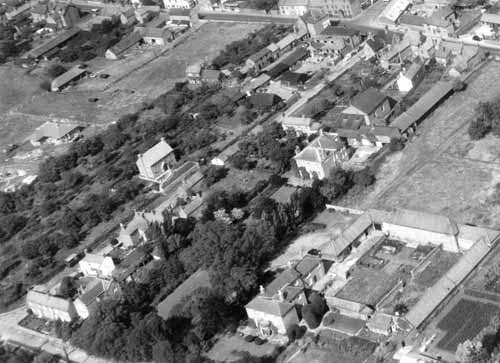
Aerial view of Fisher Lane from the south-east taken in 1957 before much of the development that has since changed Bingham so much. On the west side of Fisher Lane, except for what is now Long Acre Studios, there is only one house among the orchards.
By courtesy of Nottinghamshire County Council, Libraries, Archives and Information.
Despite the improvement in communications brought about by the railways, Kelly's 1922 trade directory, still lists many of the trades shown in White's trade directory for 1853, but it also lists 2 station masters, the gas light and coke company, 2 cycle dealers, and most importantly, 1 garage proprietor. The advent of the motor car probably brought the biggest changes to the life of the town. It allowed people from outside the area to live in Bingham and commute to their workplace when the rail service diminished after 1960, fuelling the expansion of the town that has taken place since the 1960s.
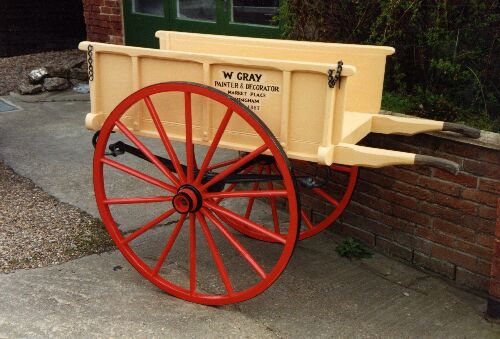
Painter's handcart, owned by Mr A.H.Whitlock, who bought it in 1936. It was used to take ladders, decorating equipment and materials to the customers' premises. It originally belonged to W.H.Gray, painters and decorators, whose premises were in the Market Place and had been long in use before 1936.
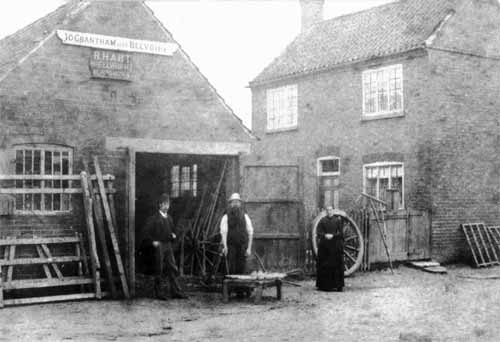
Reuben Hart’s wheelwright’s and blacksmith’s shop was at the junction of Long Acre and Long Acre East. The workshop has now gone and a modern building is in its place (Midland Computer Solutions in 2004). The cottage itself remains, but is reversed: the door seen here on the left of the building is bricked up and the main entrance now is on the right. This picture was taken around 1900.
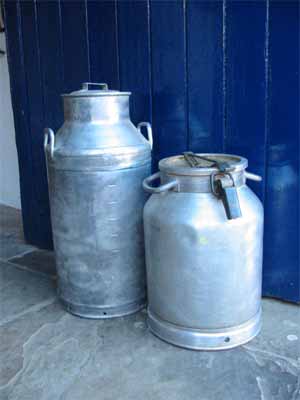
Milk churns like these were used to carry milk in the days before tankers were invented. The local milkman would have one or two on the milk float during his rounds, but they would also be used by the Dairy on the daily collection of milk from the farms.
Photo: Robin Aldworth
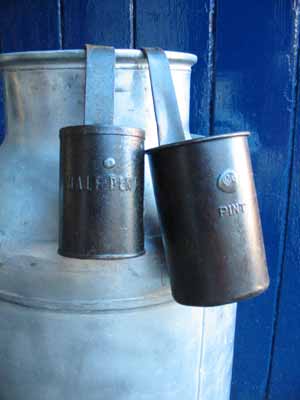
Half pint and pint milk ladles would be hung inside the milk churn so that the milkman could measure out milk on his rounds. Old ladles were made of tin-plate, but later tended to be made of aluminium.
Photo: Robin Aldworth
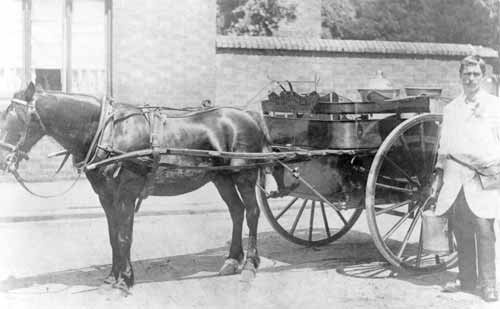
Picture taken in 1910 of the milkman Mr Hollinghead with his horse and float used for delivering milk. This way of delivering milk was common in country areas until the 1950s. The milk, carried in a large aluminium milk tank, was measured, often into a jug left on the doorstep, using standard aluminium milk ladles of one pint and one quart (two pints). Gladys Marian Benton, in her memoir (Bingham Library) remembers the milkman at the turn of the century selling eggs, cream and locally made butter on his round. Milk was 1d a pint.
By courtesy of Nottinghamshire County Council, Libraries, Archives and Information.
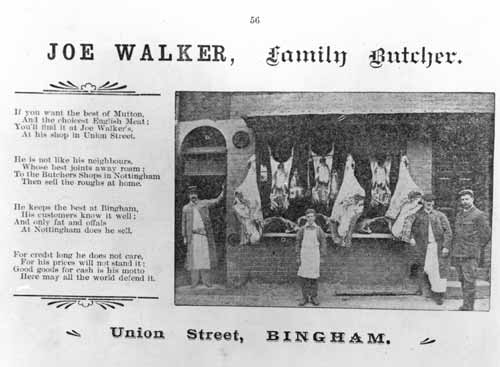
The butchers Joe Walker of Union Street and A.W. Downing of Market Place were both advertising at the same time, clearly in competition with each other. Downing passed his business on to Hopkinson, whose name is still on the shop front. Joe Walker’s had his butcher’s shop in Union Street from around 1900 to 1935 when Mr Butler took over. His name remains on the shop front even though the premises is no longer a butcher’s shop.
Photo: by permission of Maureen Gladwin
Nevertheless, Bingham continued to be primarily an agricultural town using tools and equipment little changed from the 19th century. For an account of the way farming eventually did change go to Farming in Bingham.
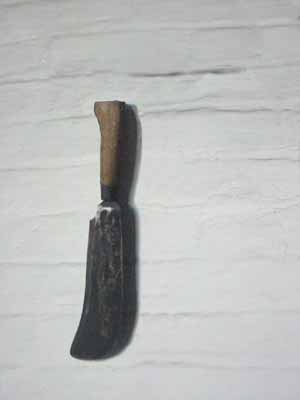
Before mechanical hedge cutters were introduced, hedges were laid by hand. Usually, this was a winter occupation, but in some big farms like the Brackendales one man was permanently employed for the maintenance of hedges and ditches. There are local versions of the bill hook with a double edged blade and with a long handle.
Photo: Robin Aldworth
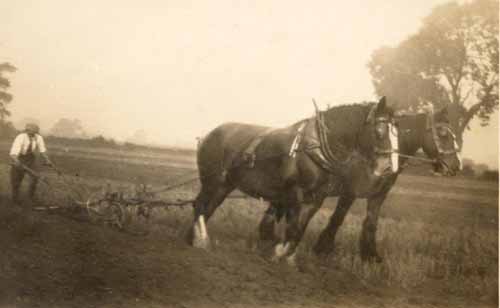
The words “The Digger” are written on the back of this picture. Black’s Agricultural Dictionary describes a digger as a type of mouldboard, abruptly concave and twisted, that produces a rough, well-broken furrow slice, as distinct from the continuous, smooth slice of the Lea plough.
Photo: courtesy of Greg Franks
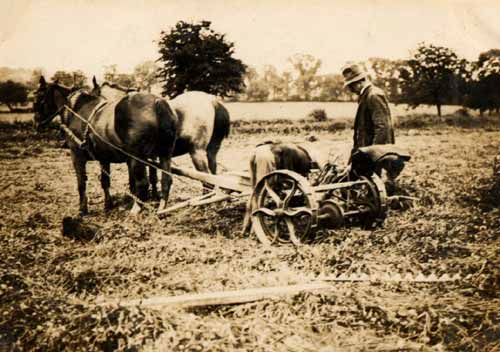
Mowing clover near Tollerton in 1927, the old fashioned way
Published by Guy & Co, Nottingham. Photo: courtesy of Greg Franks
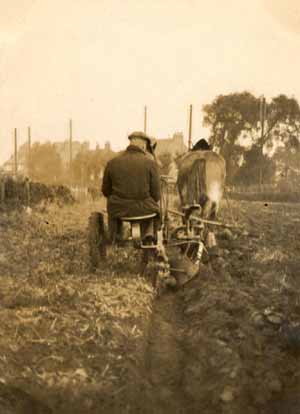
While steam ploughs were being used in parts of the area, the old-fashioned horse-drawn plough was still in use elsewhere. Here the Canadian “plow” is being used at the West Bridgford sewerage farm in 1927.
Published by Guy & Co, Nottingham. Photo: courtesy of Greg Franks
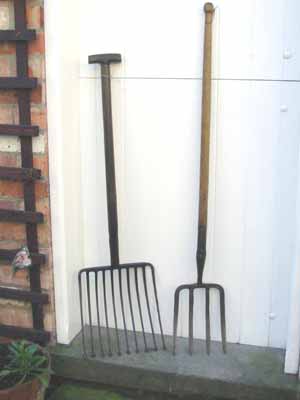
The long handled fork on the right was used for lifting potatoes. The one on the left was used for moving, lifting and loading the harvested potatoes. The small steel balls on the end of the tines are there to protect the potatos from being pierced, which would ruin them.
Photo: Robin Aldworth
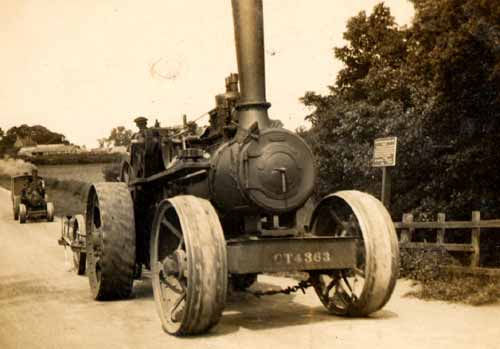
Two steam ploughs on the road near Stragglethorpe in 1927 One of the earliest steam ploughs was tested in Dumfries in 1837. It was not successful, but by the 1850s, after many different methods had been tried, they began to be widely used. There were two main types. In one a steam traction engine pulled a plough. In 1857 A Burrell-Boydell engine with 3 double ploughs ploughed 8 acres in 10 hours, compared with eighteen horses pulling six double ploughs and managing only 4 ½ acres in the same time. The steam plough was also cheaper to run than horses, ignoring the initial capital investment. The more common method used was steam ploughing by cable. This could require two engines. Though the winding drum cannot be seen in this picture it is likely that, as there are two engines, this method was used here. By the Second World War steam ploughing was well in decline.
Published by Guy & Co, Nottingham. Photo: courtesy of Greg Franks
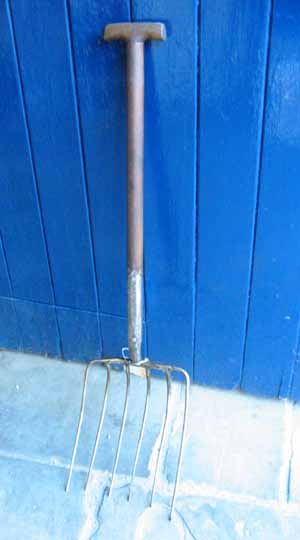
This fork was used for moving harvested sugar beet. There are fewer tines on the sugar beet fork and they are pointed and not protected in the way that the potato fork is.
Photo: Robin Aldworth
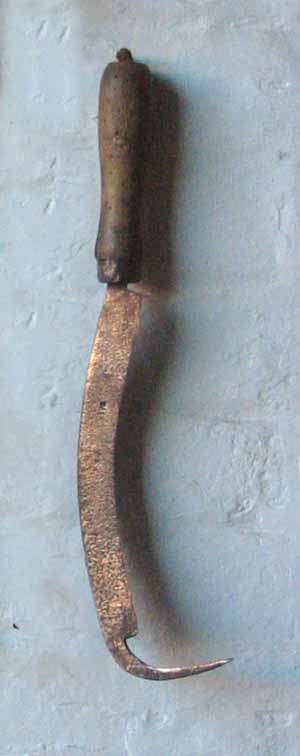
This tool has a blade about 12 inches long. It was used for topping sugar beet. The small hooked blade was used as a point for selecting and moving beets while working.
Photo: Robin Aldworth
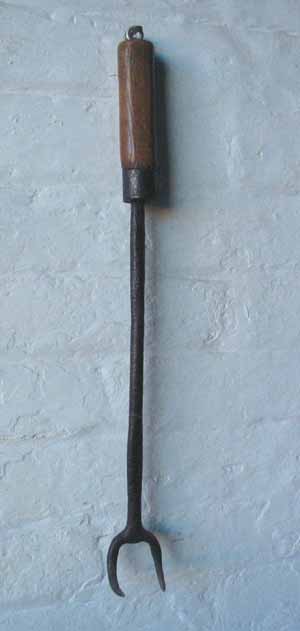
This tool, about 20 inches long was used for lifting and handling turnips when they were being harvested.
Photo: Robin Aldworth
The First World War, 1914-1918
Information about Bingham during this period can be found in the section of this website dealing with the World War One Project.
During the First World War the town lost 32 men in the trenches of Flanders. The war was literally brought home to the townspeople on Sunday evening, January 31st 1916, when several German zepperlins flew over the town on a bombing raid directed at neighbouring cities. The rector recorded the event in the parish register with the comment that future services would be held in daylight hours ‘as it was felt sure that the Germans would on the first favourable opportunity repeat this dastardly mode of warfare’.
The Second World War, 1939-1945
During the Second World War airfields at Newton and Langar had an impact on Bingham, but though there were bombing raids in the neighbourhood, the only bomb to land in the parish was out in the fields. Information about Bingham during this period can be found in the section of this website dealing with the World War Two Project. Artillery platforms and searchlight units placed around Bingham for the defence of Nottingham and Newton airfield have largely disappeared, but research in the History of Settlement project has located some of them. (See Crow Close for information about the searchlight unit there).
Bingham rebuilt
After the Second World War the Grand Clearance Scheme of 1956 lead to many old houses and cottages being demolished and the beginning of a major building programme. A decision was taken by the County Council to develop Bingham and protect the surrounding villages from expanding. It was this that led to the growth we have seen since 1956. Demolition was phased and coupled with the building of new council houses and flats, to re-house those who were thus evicted from their homes. During this post war period, it was a Government-imposed priority of local councils to ensure that people were decently housed. Water closets were therefore also installed in the pre-war council houses on Tithby Road, Stanhope Way and Nottingham Road, in order to bring them up to the required standard. Permission was also given for the building of a Fire Station and a Police Station, which may also be seen as a concern for the well-being of the townspeople.
Two outstanding buildings that were demolished at about this time, were Stanhope House, originally the Union Workhouse, later an old people’s home, and the Old Rectory, which was a grand old house with wonderful gardens, where many of the entertainments for the town were held. The Robert Miles School was later built in these grounds.
The first of the new estates, the Gough Cooper estate, was built in the early 1960s, and the Ennis estates at the Grantham end of Bingham, very soon followed. From a population of 1,604 in the year 1901, it has swelled to around 10000 in 2010.
The first green areas to disappear were the orchards and market gardens in the town and surrounding area. Then gradually, more estates were built on the green fields around the town.
The land around Bingham has been owned by the Crown Estates since the 1920s and they have controlled the expansion. They took a decision in the 1960s to rationalise farming. They consolidated all farmland into a small number of contiguous blocks and encouraged the move of farm buildings out of the town into the countryside. Now (2010) the eight farms in the parish are worked in five farm groups. Farming is almost entirely arable with only one small field (Crow Close)rented for grazing cattle. By 2010 the eight farms in the parish were worked in five farm groups. Farming was almost entirely arable with only one small field (Crow Close) rented for grazing cattle. There were no orchards or smallholdings and no market gardens.
Bingham people
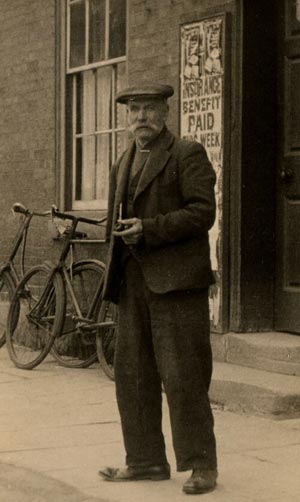
Charlie Cowdell lived with his sister "Hopping Ada" in a cottage in Fisher Lane, now demolished. He had one arm and worked for Mrs Thorpe at The Vaults pub. He is standing outside the "Welfare Office", now the Co-op car park. (Photo provided by Dot Mabbott).
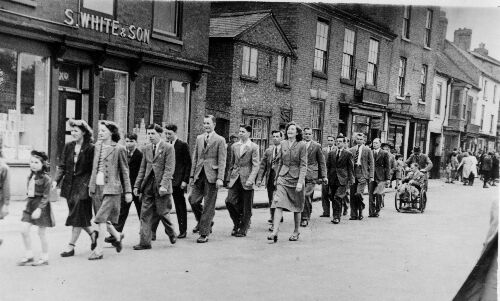
A march of Toc H members and others in 1947 or 1948 passing along the south side of Market Place. (Photo provided by Dot Mabbott).
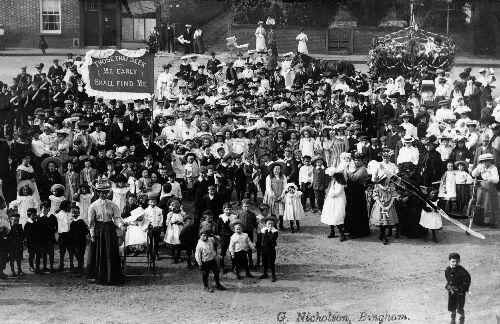
Independent Methodist Sunday School treat 1907. Taken
in the Market Place looking north. Published as a postcard by G. Nicholson. (Photo provided by Dot Mabbott).
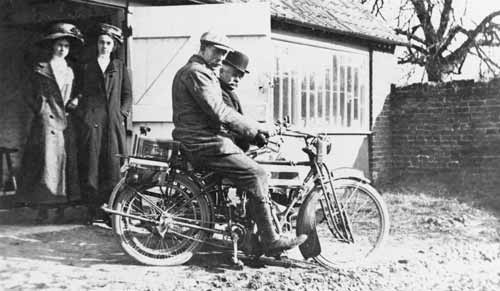
Possibly an AJS motor bike said to have been taken in 1912. The identity of the people and the locality are not known. Note the similarity with the picture of the Peugeot, dated at 1904.
By courtesy of Nottinghamshire County Council, Libraries, Archives and Information
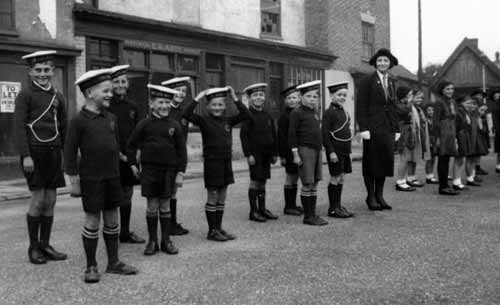
Life Boys in the Market Place in the 1930s. Keith Hammond is on the far left.
By permission of Dot Mabbott.
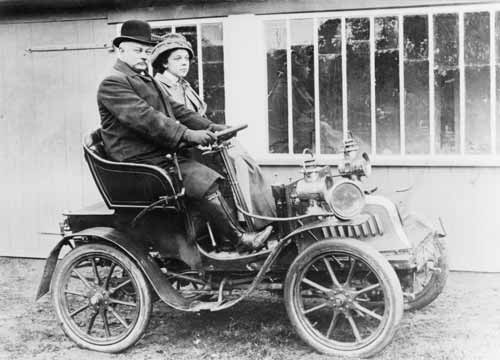
A 1902 Peugeot motor car; picture said to have been taken in about 1904. The names of the people in the car and the location are not known. Note the similarity with the AJS motor bike, said to be dated to 1912.
By courtesy of Nottinghamshire County Council, Libraries, Archives and Information

Sam Blood, the landlord of the Crown Inn, sitting in his Delaunay-Bellville outside the Crown Stables in Station Street in about 1910.
By permission of Greg Franks
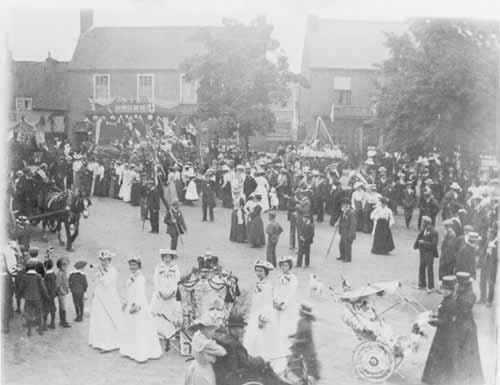
The coronation on Edward VII in 1902 was celebrated in Market Place.
By courtesy of Nottinghamshire County Council, Libraries, Archives and Information
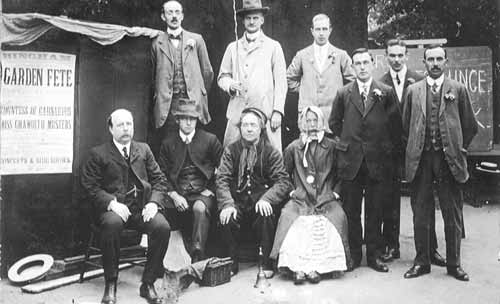
June 1914, Summer Garden Fete in the Rectory grounds. Back left is Peggy Day; seated left is Ed Hitchcock; standing third from right Oliver Fiddles (landlord Chesterfield Arms).
By permission of Greg Franks.
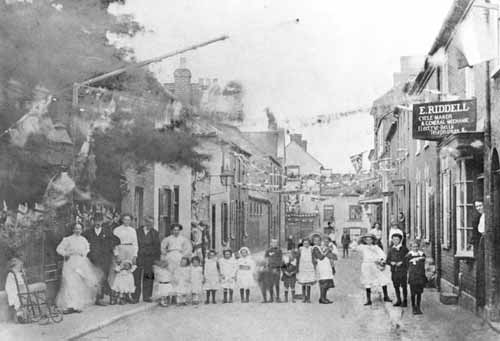
There was obviously a street party here in Union Street to celebrate the Diamond Jubilee in 1897. Most of the buildings on the left were demolished in the 1960s.
By courtesy of Nottinghamshire County Council, Libraries, Archives and Information
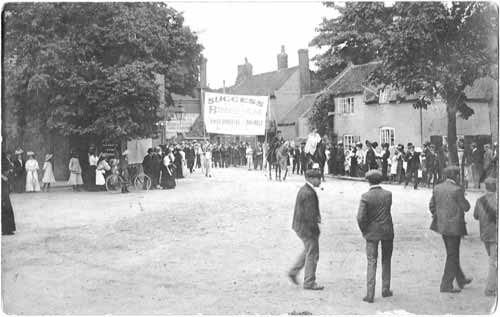
Parade of the Bingham Conservative and Unionist party in about 1910, possibly during the Summer Garden Fete.
By permission of Keith Hammond
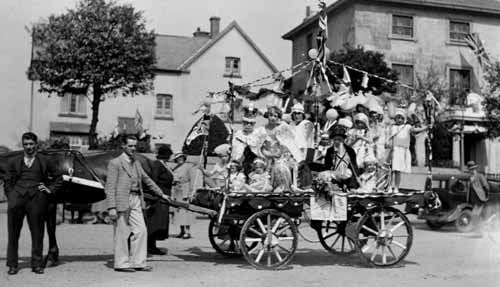
A float prepared for the summer fair in the Market Place. Eric Green is second from the left.
Photo: Dot Mabbott
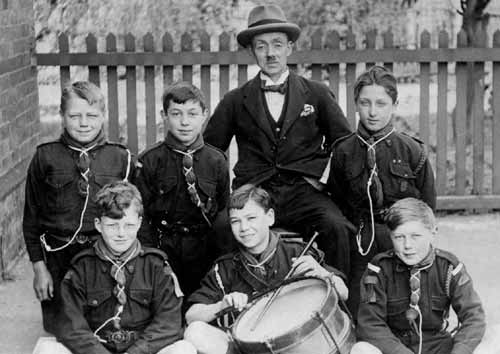
Edward Philip “Peggy” Day, the headmaster of the Church School shown with Boy Scouts. He was appointed on 7th September 1908 and retired in October 1941. Many of the older people in Bingham remember him, though no one knows for sure why he was nicknamed “Peggy”.
Photo: Dot Mabbott
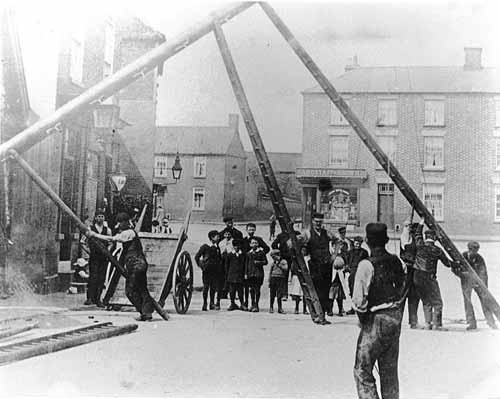
Children watching and men working putting up a new telegraph pole in Bingham Market Place. The Post Office in Bingham had telegraphy by 1900. This picture probably dates from the early 1900s.
